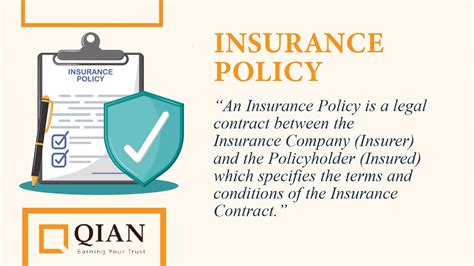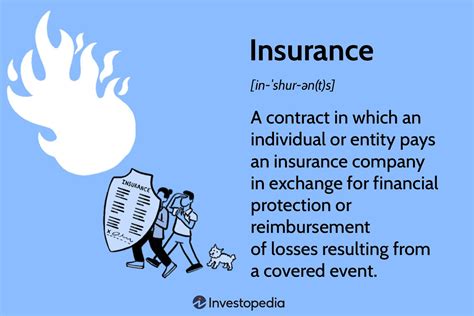Define Policy Insurance

Policy insurance is a crucial concept within the insurance industry, serving as a contractual agreement between an insurer and an insured party. This agreement outlines the terms and conditions under which the insurer provides financial protection to the insured against specific risks and uncertainties. Policy insurance is a fundamental tool for managing and mitigating risks, offering peace of mind and financial security to individuals, businesses, and organizations.
Understanding the Basics of Policy Insurance

At its core, a policy insurance is a legally binding document that details the rights and obligations of both parties involved. The insured, often referred to as the policyholder, pays a premium to the insurer in exchange for the promise of financial coverage in the event of a covered loss or damage. This coverage can extend to a wide range of risks, including health issues, property damage, liability claims, and more.
Policy insurance is not a one-size-fits-all solution. It is highly customizable, allowing policyholders to tailor their coverage to their specific needs and circumstances. This flexibility ensures that individuals and businesses can secure the protection they require without unnecessary expenses.
Key Components of a Policy Insurance
Every policy insurance consists of several essential elements, each playing a crucial role in defining the scope and nature of the coverage provided:
- Declarations Page: This section provides an overview of the policy, including the insured’s name, the policy period, the types of coverage, and the limits of liability.
- Insuring Agreement: Here, the insurer agrees to provide coverage for specific risks outlined in the policy, subject to the terms and conditions stated.
- Exclusions: The policy will clearly state what risks or events are not covered. These exclusions are critical to understanding the limitations of the policy.
- Conditions: These are the rules and requirements that the insured must follow to maintain coverage. Non-compliance with these conditions can result in the denial of a claim.
- Definitions: The policy will define key terms used throughout the document to ensure a clear understanding of the coverage provided.
- Endorsements and Riders: These are amendments to the policy that can add or remove coverage, adjust limits, or modify other terms. They are often used to customize the policy to the insured’s specific needs.
Policy insurance is a complex yet vital tool for managing risk. It provides a safety net for individuals and businesses, allowing them to focus on their goals and objectives without the worry of unforeseen financial burdens.
Types of Policy Insurance

The insurance industry offers a wide array of policy insurance types, each designed to address specific risks and concerns. Here are some of the most common types of policy insurance:
Life Insurance
Life insurance policies provide financial protection to the policyholder’s beneficiaries in the event of their death. These policies can be tailored to meet specific needs, offering coverage for a set period or for the policyholder’s entire life. Common types of life insurance include term life, whole life, and universal life insurance.
Health Insurance
Health insurance policies cover the costs associated with medical care, including doctor visits, hospital stays, prescription drugs, and more. These policies can be obtained individually or through an employer and often feature a network of preferred providers to keep costs down. Common health insurance plans include Health Maintenance Organizations (HMOs), Preferred Provider Organizations (PPOs), and Exclusive Provider Organizations (EPOs).
Property Insurance
Property insurance policies protect the insured’s possessions and property against damage or loss due to various perils, such as fire, theft, vandalism, and natural disasters. This type of insurance can cover homes, businesses, and their contents. Homeowner’s insurance and renter’s insurance are common forms of property insurance.
Auto Insurance
Auto insurance policies provide financial protection against physical damage, bodily injury, and liability claims arising from the use of an automobile. These policies are mandatory in many jurisdictions and typically include coverage for liability, collision, comprehensive, and uninsured/underinsured motorist protection.
Liability Insurance
Liability insurance policies protect the insured against claims resulting from injuries or property damage caused to others. This type of insurance is particularly important for businesses, as it can cover legal fees and damages arising from lawsuits. Common forms of liability insurance include general liability insurance, professional liability insurance (also known as errors and omissions insurance), and product liability insurance.
Business Insurance
Business insurance policies are designed to protect businesses against a wide range of risks, including property damage, liability claims, and business interruption. These policies can be tailored to meet the specific needs of various industries and business sizes. Common types of business insurance include commercial property insurance, commercial general liability insurance, business interruption insurance, and professional liability insurance.
The Process of Obtaining Policy Insurance
Obtaining policy insurance involves a series of steps designed to ensure the policyholder receives the coverage they need. Here’s a general overview of the process:
Step 1: Identifying Needs
The first step is to identify the specific risks and needs that require insurance coverage. This could involve assessing personal or business assets, potential liabilities, and other factors that could lead to financial loss.
Step 2: Researching Insurance Options
Once the needs are identified, it’s time to research the available insurance options. This step involves comparing different policies, insurers, and coverage levels to find the best fit. Online resources, insurance brokers, and financial advisors can be valuable assets during this process.
Step 3: Applying for Insurance
After selecting the appropriate insurance policy, the next step is to apply. This often involves filling out an application form that requests personal or business information, details about the risks to be covered, and other relevant details. The insurer will use this information to assess the risk and determine the premium.
Step 4: Reviewing the Policy
Upon receiving the policy, it’s crucial to thoroughly review it to ensure it meets the expected coverage needs. This step involves understanding the policy’s terms, conditions, exclusions, and any endorsements or riders. If there are any discrepancies or concerns, the policyholder should contact the insurer to make the necessary adjustments.
Step 5: Maintaining and Updating Coverage
Policy insurance is not a set-and-forget solution. It’s important to regularly review and update coverage to ensure it continues to meet changing needs. This could involve adjusting coverage limits, adding or removing endorsements, or switching insurers to find a better fit.
The Importance of Policy Insurance
Policy insurance plays a vital role in modern society, offering numerous benefits to individuals and businesses alike. Here are some key reasons why policy insurance is essential:
Financial Protection
Policy insurance provides a vital layer of financial protection against unexpected events and losses. Whether it’s a medical emergency, a natural disaster, or a liability claim, insurance coverage can help mitigate the financial impact, ensuring individuals and businesses can recover and move forward.
Peace of Mind
Knowing that one has insurance coverage can provide a sense of security and peace of mind. Policyholders can focus on their daily lives and business operations without constantly worrying about potential risks and their financial consequences.
Risk Management
Insurance is a powerful risk management tool. By transferring the financial burden of potential losses to an insurer, policyholders can better manage their risks and make informed decisions. This allows for more effective planning and resource allocation.
Access to Specialized Services
Some policy insurance policies, particularly in the health and liability sectors, provide access to specialized services and networks. For example, health insurance policies often come with networks of preferred providers, ensuring policyholders can receive quality care at discounted rates.
Legal and Regulatory Compliance
Certain types of policy insurance are mandatory under law or regulatory requirements. For instance, auto insurance is typically required for all vehicle owners, and businesses may be required to carry specific types of insurance to comply with industry standards and regulations.
In conclusion, policy insurance is a vital tool for managing risks and uncertainties in today's world. By understanding the different types of policy insurance, the process of obtaining coverage, and the importance of this protection, individuals and businesses can make informed decisions to safeguard their financial well-being.
What is the difference between policy insurance and general insurance?
+Policy insurance is a specific type of insurance that refers to the contract between an insurer and an insured party, detailing the coverage provided. General insurance, on the other hand, is a broader term that encompasses various types of insurance, including policy insurance, that provide protection against non-life risks such as property damage, liability claims, and more.
How do I choose the right policy insurance for my needs?
+Choosing the right policy insurance involves assessing your specific needs and risks. Consider factors such as the value of your assets, potential liabilities, and the financial impact of various risks. Research and compare different policies, insurers, and coverage levels to find the best fit. It’s also beneficial to consult with insurance professionals or financial advisors for guidance.
Can policy insurance be customized to meet my specific needs?
+Yes, policy insurance is highly customizable. Insurers often offer a range of options and endorsements that allow policyholders to tailor their coverage to their specific needs. This flexibility ensures that individuals and businesses can secure the protection they require without unnecessary expenses.


